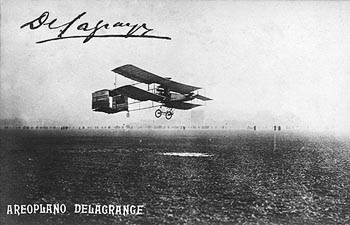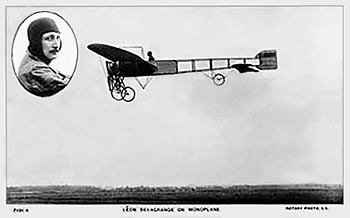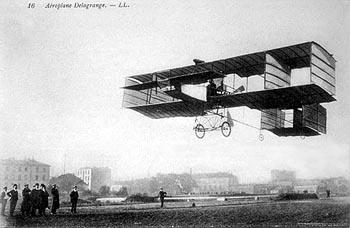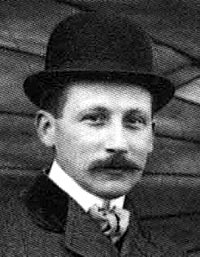
Ferdinand Léon Delagrange (1873-1910)
Ferdinand Léon Delagrange (1873-1910) bought one of the first Voisins at the same as Henry Farman in 1907. In March 1908 he carried the first passenger in Europe, who was Henry Farman himself. He also took up the first woman to fly, Madame Peltier, in July 1908 at Milan. She took several lessons which culminated in piloting the Voisin solo, but she did not take her interest any further. Ferdinand Léon Delagrange, 1906
and from the same site... The only other prominent aviator during this period was Ferdinand Léon Delagrange who, like Farman, had purchased a standard Voisin in 1907. However he was less technically-minded than Henry and had made only a few modifications to the basic design. Gabriel Voisin remarked that in contrast to Farman, Delagrange "was not the sporting type" and knew nothing about running an engine.
 Léon Delagrange, 1909
Nevertheless a sporting rivalry seems to have developed between the two fliers. Delagrange went south to Italy to demonstrate the art of flying while Farman went north to Belgium. On 23 June Delagrange set an endurance record of 18 minutes, 30 seconds at Milan: Farman retaliated with 20 minutes, 20 seconds at Ghent, on 6 July. On 6 September Delagrange flew for 25km (15 miles) at Issy: Farman bested that with 40km (25 miles) at Champ de Chalons on 2 October.
 Léon Delagrange Volera, 1908 Download a 750pixel image
Il primo volo in Italia si fece a Roma il 24 maggio 1908, nella piazza d'Armi, in una giornata piovigginosa. Il pilota era il francese Ferdinand Léon Delagrange su un aereo Voisin del peso di 555 kg., spinto da un motore Antoinette da 50 C.V. ad 8 cilindri con raffreddamento ad acqua.
Ferdinand Léon Delagrange visits Rome, 1908 In 1908, the French pilot Ferdinand Léon Delagrange visited Rome in preparation for flight demonstrations. The airplane manufacturer Gabriel Voisin accompanied him, and Mario Calderara asked Voisin if he could come to Paris and work in his shop as a draftsman and designer. Voisin agreed, and Calderara applied to the Italian Admiralty for a six months leave of absence without pay. In July 1908 he (Calderara) traveled to Issy Les Moulineaux (near Paris) and worked in the shop of Gabriel Voisin (The two had become very good friends and collaborated on new ideas). After helping in the design of several airplanes, he was offered by Mr. Ambroise Goupy, a wealthy Frenchman who was interested in flight, the opportunity of designing and manufacturing, funded by Goupy, a new type of flying machine, very light and small: a "tractor propelled biplane", the first of its type. He built the airplane, called "Calderara Goupy" and flew it successfully on March 11th, 1909 in Buc (France).
A History of Aeronautics
XVII. A SUMMARY, TO 1911 Ferdinand Léon Delagrange on a Voisin biplane, he made the first passenger flight. On April 10th of this year, Delagrange, in flying 1 1/2 miles, made the first flight in Europe exceeding a mile in distance. He improved on this by flying 10 1/2 miles at Milan on June 22nd, while on July 8th, at Turin, he took up Madame Peltier, the first woman to make an aeroplane flight.
 Léon Delagrange flying a Bleriot Monoplane, 1909
1910 opened with tragedy, for on January 4th Ferdinand Léon Delagrange, one of the greatest pilots of his time, was killed while flying at Pau. The machine was the Bleriot XI which Delagrange had used at the Doncaster meeting, and to which Delagrange had fitted a 50 horse-power Gnome engine, increasing the speed of the machine from its original 30 to 45 miles per hour. With the Rotary Gnome engine there was of necessity a certain gyroscopic effect, the strain of which proved too much for the machine. Delagrange had come to assist in the inauguration of the Croix d'Hins aerodrome, and had twice lapped the course at a height of about 60 feet. At the beginning of the third lap, the strain of the Gnome engine became too great for the machine; one wing collapsed as if the stay wires had broken, and the whole machine turned over and fell, killing Delagrange. On January 7th Latham, flying at Mourmelon, first made the vertical kilometre and dedicated the record to Delagrange, this being the day of his friend's funeral.
A Turn for the Purse The French were in the air and in the news in the spring of 1908. Gabriel Voison was manufacturing airplanes made to order. He had formed a brief partnership with Louis Bleriot and built two airplanes with him - a biplane glider and a powered biplane. The glider flew poorly and the powered version didn't fly at all, which Voisin blamed on Bleriot's unusual ideas and his erratic approach to aeronautical engineering.Bleriot would try anything, sometimes making drastic changes to the aircraft such as substituting elliptical wings for conventional wings. So Voison left Bleriot to his own devices and teamed up with his brother Charles. They established the first airplane factory in the world at Billancourt, France, making any design that a customer wanted. A Russian prince ordered a craft with a propeller in the shape of a spiral staircase. A Dutchman paid for a set of wings grafted onto a "kind of car" - it failed to fly. But their most successful aircraft were those they designed themselves. Earlier, they had made a float-glider for Archdeacon with biplane wings and an elevator in front, similar to the standard Wright configuration. But they had added a box-kite tail and side curtains between the wings. The craft, which was in fact a giant box kite with an elevator and a rudder, flew reasonably well.
 Aeroplane Delagrange Download a 750pixel image
In 1907, they made a similar airplane for Ferdinand Léon Delagrange, mounting a 50-horsepower Antionette engine and a propeller on the lower wing to push it through the air. Although it had no roll control, Delagrange was able to make short hops of up to 500 meters (1650 feet). As such, the Voisin-Delagrange I was the first European airplane to best the Wright's first powered flights in 1903. Later on that year, Henri Farman found his way to the Voison aircraft plant. Farman was the son of a prominent journalist who had been bitten by the aviation bug. He first took to the air in a home-built Chanuet-Herring glider, then sought out the Voison brothers for something with power. Farman carefully looked over the plans Gabriel and Charles laid before him, then ordered a Voison aircraft with a few minor - but important - modifications. Farman began to fly the Voison-Farman I on September 30, 1907, making a modest hop of just 30 meters (100 feet). Thereafter, he began to stretch the distance little by little. He also modified the airplane as he gained more flying experience, eliminating the side curtains, reducing the size of the tail, and adjusting the dihedral angle of the wings, all to reduce drag, improve stability, and make the airplane more maneuverable. However, even in its final form, it had no roll control - Farman made do with an elevator and rudder only. On October 26, 1907, Farman made a flight of 712 meters (2,350 feet) and won a second Archdeacon Cup. This was a prize that Ernest Archdeacon had offered to the aviator who made the longest flight duringthe year. On November 19, 1907, Farman made a run at the Grand Prix de Aviation, but didn't quite complete the circular course. Orville Wright, who was still in Europe, witnessed Farman's flight. When asked by the reporters for a comment on the rapid progress of French aviation, he was cool and criticized the French airplane's control system obliquely.
"Time will show whether the methods of control used in the Farman machine are adequate to meet the conditions encountered in windy weather," he was quoted. Privately, he wrote to Chanute that the French were busy but "we see no indication of a practical machine in the near future."Archdeacon, ever the Wright detractor, took affront at Orville's attitude.
"The famous Wright brothers may claim all they wish," he blustered. "If it were true - and I doubt it more and more - that they were the first to fly through the air, they will not have the glory. The first authentic experiments in powered aviation have taken place in France; they will progress in France; and the Wrights will, I am sure, be beaten by us as well before they will have decided to show their phantom machine."On January 13, 1908, Farman took off again in pursuit of the Grand Prix de Aviation and its 50,000 franc purse. He made a flying start, crossing the starting poles about 4 meters or 13 feet off the ground. He flew straight out for about 500 meters, slowly climbing to 12 meters or 40 feet, then made a wide, flat turn, using rudder alone to slide around the marker. He came back and made another turn, crossed the point at which he started, and landed gently. The entire flight lasted 28 seconds, and covered the prescribed kilometer. It didn't matter that his turns were clumsy and he was in constant danger of losing control of the Voison-Farman I. Henri Farman had won the most coveted prize in aviation, and for the moment - as far as the French were concerned - the Wright brothers were beaten.
|
© Copyright 1999-2002 CTIE - All Rights Reserved - Caution |
 Ferdinand Léon Delagrange
Ferdinand Léon Delagrange